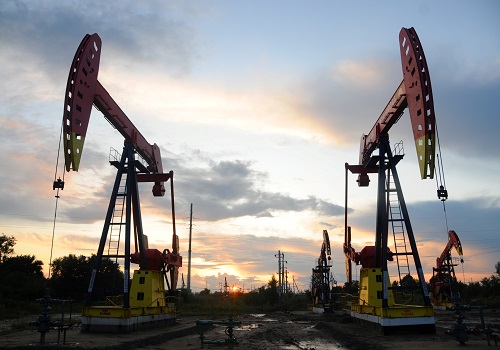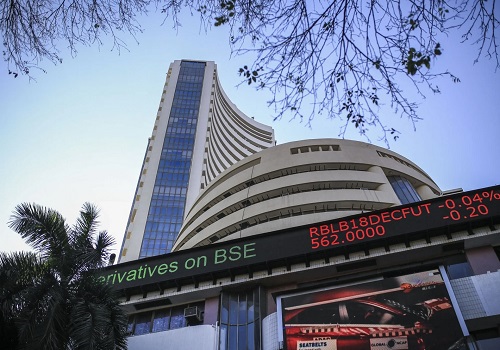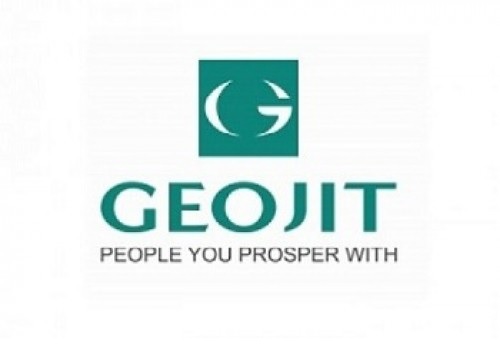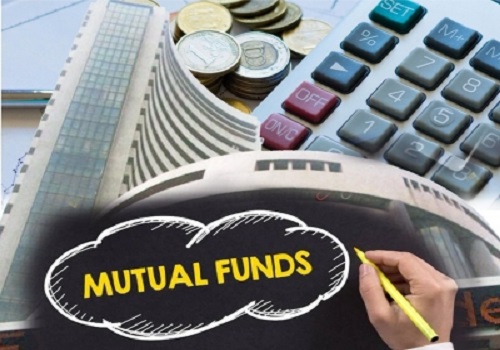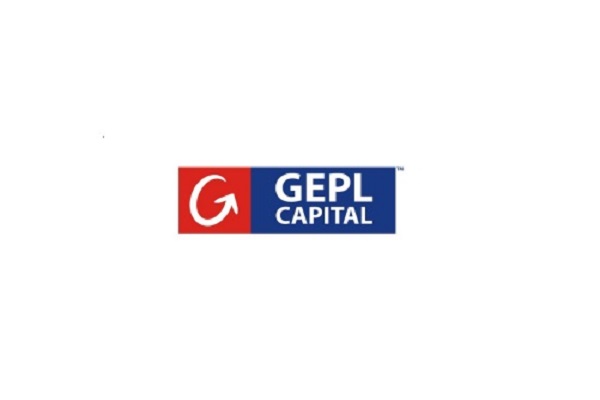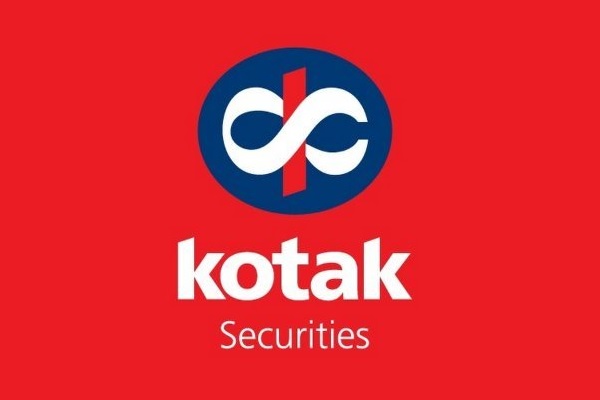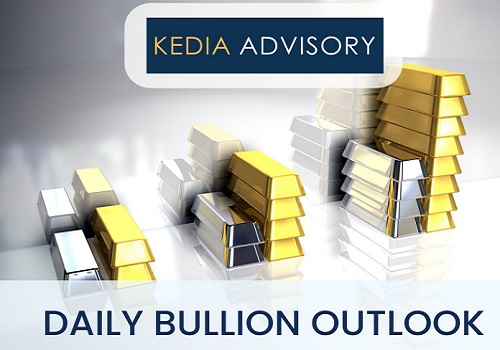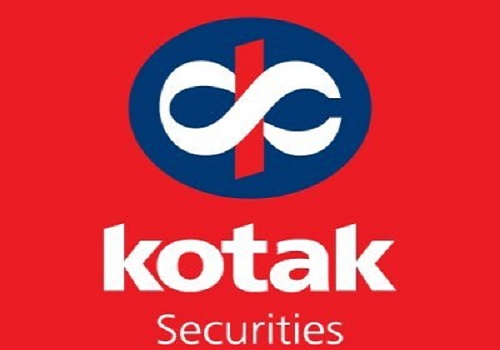Jeera trading range for the day is 19540-20380 - Kedia Advisory

Gold
Gold prices climbed 0.88% to settle at Rs.98,579, supported by renewed investor caution amid a series of weak U.S. economic indicators. The latest Job Openings and Labor Turnover Survey (JOLTS) reported 7.39 million job openings in April, exceeding expectations but still reflecting broader uncertainty in the labor market. Commentary from Fed officials also highlighted trade policy as a key economic risk, with concerns about the potential macroeconomic impact of new tariffs adding to gold's safe-haven appeal. On the global front, central bank gold buying remained positive but slowed, with a net 12 tonnes added in April—down 12% from March and well below the 12-month average. Poland led central bank purchases, lifting its reserves to 509 tonnes, surpassing the European Central Bank’s holdings. Despite sustained central bank interest, high gold prices have dampened physical demand in key markets like India, where the end of the wedding season and elevated prices led to discounts of up to $31 per ounce. Similarly, Chinese premiums narrowed, indicating moderated retail appetite despite robust April imports via Hong Kong. Technically, the market is under fresh buying, with open interest rising 8.39% to 17,236. Gold has immediate support at Rs.97,945 and could test Rs.97,310 if selling intensifies. On the upside, resistance is seen at Rs.98,950, with further gains likely toward Rs.99,320 on a breakout.
Trading Ideas:
* Gold trading range for the day is 97310-99320.
* Gold gains as a series of weak US economic reports renewed concerns over the outlook.
* The number of job openings on the last business day of April stood at 7.39 million versus 7.2 million prior.
* Central banks added a net 12 tonnes of Gold to global Gold reserves in April, 12% lower than the previous month
Silver
Silver prices edged up by 0.16% to settle at Rs.101,380, supported by persistent uncertainty over U.S.-China trade relations and broader global economic concerns. The weaker U.S. dollar further enhanced silver’s safe-haven appeal. Warnings from the OECD about a sharper-than-expected global slowdown, exacerbated by the Trump administration’s aggressive trade policies, weighed heavily on market sentiment. Meanwhile, news of potential talks between U.S. President Donald Trump and China’s Xi Jinping offered some hope for easing tensions. Domestically, the U.S. labor market showed mixed signals, with a rise in job openings offset by a surge in layoffs to a nine-month high, signaling softening momentum. From a fundamental perspective, the silver market remains on solid footing. The Silver Institute forecasts another supply-demand deficit in 2025, marking the fifth consecutive year of shortfall. Industrial demand, a key pillar, is projected to hit a new high, bolstered by growth in green energy sectors. Silver industrial fabrication is expected to rise by 3%, exceeding 700 million ounces for the first time. Investment demand is also projected to grow by 3%, driven by recovery in Europe and North America. Technically, the market is in short covering mode, with open interest down 0.18% to 17,570. Silver finds support at Rs.100,845, with further downside testing Rs.100,310, while resistance lies at Rs.101,790 and a breakout could lead to Rs.102,200.
Trading Ideas:
* Silver trading range for the day is 100310-102200.
* Silver crossed Rs.1 lakh amid U.S.-China trade tensions and global growth fears.
* Weaker dollar and OECD’s economic slowdown warning fueled safe-haven demand for silver.
* Fed officials maintained a cautious tone, citing trade risks and economic uncertainties.
Crude oil
Crude oil prices declined by 1.26% to settle at Rs.5,386 amid a bearish tilt driven by a substantial build in U.S. gasoline and diesel inventories. Fuel supplies rose sharply, raising concerns over sluggish demand, especially with OPEC+ planning to boost output by 411,000 barrels per day in July after similar hikes in May and June. The bearish sentiment was further reinforced by weak demand data from the U.S., where oil product consumption fell to a one-year low, despite crude production reaching a record 13.488 million barrels per day in March, surpassing the previous peak. However, downside pressure was somewhat limited due to several supportive factors. Geopolitical risks, including the stalling U.S.-Iran nuclear talks and Canadian wildfires disrupting 7% of oil output, offered some cushion. While rainfall helped ease the wildfire situation, ongoing disruptions still pose a supply risk. The recent crude inventory drop of 4.304 million barrels, the largest since November 2024, also added a layer of bullishness. Yet, swelling refined product inventories—gasoline up 5.219 million barrels—kept the overall tone cautious. Technically, the market is witnessing long liquidation, with open interest falling by 19.59% to 6,286. Crude oil finds support at Rs.5,329, with further downside toward Rs.5,271. Resistance is seen at Rs.5,468, and a breakout above could take prices to Rs.5,549.
Trading Ideas:
* Crudeoil trading range for the day is 5271-5549.
* Crude oil settled down after U.S. data showed surprisingly large build in gasoline and diesel inventories
* Wildfires in Canada temporarily disrupted about 7% of the country’s oil output
* OPEC+ announced a production increase of 411K barrels per day for July, following similar hikes in May and June.
Natural gas
Natural gas prices fell by 0.47% to settle at Rs.318.3, weighed down by easing demand expectations and a decline in LNG export flows. Average gas deliveries to the eight major U.S. LNG export terminals dropped to 13.8 billion cubic feet per day (bcfd) so far in June, down from 15.0 bcfd in May and a record 16.0 bcfd in April. This decline is largely attributed to routine spring maintenance activities, particularly at Cheniere Energy’s facilities. On the weather front, forecasts indicate warmer-than-usual temperatures through mid-June, which could cap heating demand but may later boost cooling-related consumption. On the supply side, gas production in the Lower 48 states also dipped slightly to 104.0 bcfd in June, compared to 105.2 bcfd in May and March’s record of 106.3 bcfd. Despite this marginal decline, U.S. storage levels are steadily rising. For the week ending May 23, utilities added 101 billion cubic feet to storage, in line with expectations. Total gas in storage now stands at 2.476 trillion cubic feet—11.3% below last year’s level but 3.9% above the five-year average, keeping market balance in check. Looking ahead, the EIA projects record-high production and consumption in 2025, with dry gas output rising to 104.9 bcfd and consumption hitting 91.3 bcfd. Technically, the market is under fresh selling pressure, with open interest rising by 5.43% to 14,924, indicating renewed bearish positioning. Support is pegged at Rs.315.1, with deeper support at Rs.311.9. Resistance lies at Rs.320.9, and a move above this could push prices toward ?323.5.
Trading Ideas:
* Naturalgas trading range for the day is 311.9-323.5.
* Natural gas dropped as demand expectations eased and LNG export flows declined.
* Gas sent to the eight major US LNG export terminals averaged 13.8 bcfd so far in June.
* Average gas production in the Lower 48 states fell slightly to 104.0 bcfd so far in June.
Copper
Copper prices rose 0.46% to settle at Rs.875.65, driven by renewed market speculation that U.S. President Donald Trump may impose additional tariffs—this time possibly on copper—after announcing a doubling of levies on aluminium and steel imports. These tariff threats have stirred concerns over global copper supply chains and added a speculative boost to prices. However, upside momentum remained capped by weak economic signals from China. A private manufacturing survey showed activity in May fell to a two-year low, mirroring the official PMI report which also pointed to a second consecutive monthly contraction. This reinforces concerns about slowing Chinese industrial demand, especially as export orders continue to drop under the weight of U.S. trade policies. On the supply side, global copper fundamentals remain tight. LME inventories fell to a near one-year low of 143,850 tons after a 4,600-ton outflow, while Shanghai Futures Exchange stocks plunged 60% in April, the steepest decline on record. Meanwhile, Chile’s copper production surged 13.5% year-on-year in April to 463,639 tons, adding some supply-side cushion. COMEX inventories in the U.S. spiked 61% since March as traders diverted global shipments in anticipation of tariff effects. From a technical perspective, the copper market is under fresh buying pressure, indicated by a 2.63% increase in open interest to 7,015. Immediate support lies at Rs.872.8, with deeper support at Rs.869.8. Resistance is now seen at Rs.877.9, and a break above this could open the path to test Rs.880.
Trading Ideas:
* Copper trading range for the day is 869.8-880.
* Copper gains after speculation about possible new import tariffs.
* LME stocks dropped to 143,850 tons, a yearly low, after 4,600-ton daily outflow.
* Private and official PMIs showed China’s factory activity contracted for a second month.
Zinc
Zinc prices edged higher by 0.31% to settle at Rs.255.95, supported by a nearly 5% weekly drop in inventories on the Shanghai Futures Exchange, highlighting tightening supply conditions. This drawdown comes amid ongoing maintenance at several Chinese smelters and already low stock levels, reinforcing the bullish supply-side sentiment. However, broader upside remains capped as global metal markets remain under pressure due to heightened trade uncertainties. U.S. President Donald Trump's announcement to double tariffs on imported steel and aluminium to 50% has fueled fresh tensions with the European Union, unsettling investor sentiment and dampening risk appetite across commodities. On the demand front, China's industrial outlook remains tepid, with the country's manufacturing PMI contracting for the second consecutive month. This persistent slowdown raises expectations of further economic stimulus from Beijing, which could eventually reignite industrial demand and support zinc consumption. Meanwhile, the global zinc market surplus narrowed significantly to 23,700 metric tons in March from 75,900 tons in February, according to the ILZSG, reflecting improving market balance. In terms of production, China's refined zinc output rose 1.6% month-on-month and approximately 10% year-on-year in April 2025. However, year-to-date growth remains modest at just 0.3%, below earlier expectations. Technically, the zinc market is under fresh buying pressure with a 4.61% increase in open interest to 3,178. Support is seen at Rs.254.7, with lower support at Rs.253.4. Resistance is likely at Rs.257.6, with a break above paving the way toward Rs.259.2.
Trading Ideas:
* Zinc trading range for the day is 253.4-259.2.
* Zinc gains as Shanghai zinc inventories declined nearly 5%, reflecting tight supply from ongoing smelter maintenance.
* However upside seen limited amid global trade concerns and broad weakness in metal markets.
* China’s manufacturing PMI contracted for a second month, pressuring zinc demand outlook.
Aluminium
Aluminium prices rose by 0.77% to settle at Rs.241.3, driven by concerns over impending tariff hikes on steel and aluminium imports, following U.S. President Donald Trump's announcement to double existing tariffs to 50%. This move triggered a sharp reaction in the physical market, with the U.S. Midwest duty-paid aluminium premium soaring by 54% to $1,279 per metric ton, reflecting heightened supply concerns amid rising geopolitical friction. However, upside momentum remains tempered by soft macroeconomic indicators, especially from China—the world's largest aluminium consumer and producer. China's factory activity contracted for the first time in eight months, with the Caixin/S&P Global manufacturing PMI falling to 48.3 in May, the lowest in 32 months, and the official PMI confirming a second month of decline. These figures point to weakening domestic demand, likely exacerbated by trade tensions and faltering global growth. Despite the macroeconomic headwinds, Goldman Sachs revised its aluminium price forecast for H2 2025 upward by $140 to $2,280/ton, citing a smaller-than-expected global surplus and raising global demand growth expectations from 1.1% to 1.8% year-on-year. China's aluminium production rose by 4.2% year-on-year to 3.75 million tons in April, while cumulative output for the first four months reached 14.79 million tons, up 3.4%. Technically, the market is witnessing short covering, with open interest slipping by 0.25% to 4,372. Support lies at Rs.240.1, with further downside possible to Rs.238.7, while resistance is seen at Rs.242.3, and a breakout could push prices toward Rs.243.1.
Trading Ideas:
* Aluminium trading range for the day is 238.7-243.1.
* Aluminium gains amid looming tariff hikes on steel and aluminium.
* Goldman Sachs raised H2 2025 aluminium forecast to $2,280/ton on tighter surplus outlook.
* U.S. Midwest aluminium premiums surged 54% after Trump announced tariff hikes to 50%.
Turmeric
Turmeric futures surged by 2.24% to settle at Rs.14,086, driven by persistent concerns over lower production estimates and quality issues, despite an uptick in market arrivals. The sharp rise in arrivals — from 29,860 quintals to approximately 57,500 quintals — initially appeared bearish but failed to suppress bullish sentiment fueled by expectations of a 10–15% drop in new crop yields. This anticipated shortfall is attributed to untimely rains, particularly affecting key regions like Nanded, where smaller rhizomes and crop rot have been reported. Though the acreage under turmeric cultivation has expanded by 10% this season to 3.30 lakh hectares, productivity gains are not expected to match the acreage increase, keeping output concerns alive. The market is also witnessing strong buying interest for the fresh crop, especially in Duggirala, where new stock is fetching premiums over older inventory due to its superior quality. With nearly 50–55% of the new crop already traded and arrivals continuing into June, market activity is projected to remain vibrant. Turmeric exports in FY2024–25 rose by 8.83% to 176,325 tonnes compared to the previous year, showing steady international demand. However, monthly export data is mixed — March 2025 exports fell 13.41% YoY but rose 20.39% over February 2025. Technically, the market is under short covering as open interest declined by 8.94% to 13,285 lots, while prices gained Rs.308. Turmeric finds support at Rs.13,744, with a breach potentially testing Rs.13,402. On the upside, resistance is seen at Rs.14,314, and a breakout may push prices toward Rs.14,542.
Trading Ideas:
* Turmeric trading range for the day is 13402-14542.
* Turmeric gains amid persistent concerns about low arrivals and lower production estimates.
* However upside seen limited due to increased arrivals and owing to weak export enquiries.
* Turmeric exports during Apr - Mar 2025, jump by 8.83 percent at 176325.34 tonnes compared to Apr - Mar 2024.
* In Nizamabad, a major spot market, the price ended at 14467.1 Rupees gained by 0.54 percent.
Jeera
Jeera futures slipped by 1.85% to close at Rs.19,880, pressured by sluggish domestic and export demand, along with rising arrivals in key mandis. The recent decline is largely attributed to the end of the retail buying season and muted interest from overseas buyers. Total mandi arrivals rose to 32,900 bags, up from 28,000 in the previous session, creating additional supply-side pressure. Furthermore, traders noted that export demand remains subdued, with current requirements being met from existing inventories. Although the sowing of jeera was delayed by a month in Gujarat and Rajasthan due to unfavourable weather, production for the current season is expected to match last year’s levels owing to improved crop conditions and good sowing practices. Farmers are reportedly holding around 20 lakh bags, out of which only 3–4 lakh bags are likely to be traded by season’s end, leading to a substantial carry-forward stock of nearly 16 lakh bags — another factor dampening prices. Despite the recent price softness, jeera exports saw a healthy 39.63% jump in FY2024–25 to 212,502 tonnes from 152,189 tonnes a year earlier. However, March exports declined 46% year-on-year but grew over February by 33.4%, reflecting seasonal volatility. Technically, the market is under long liquidation, with open interest falling by 7.61% to 4,917 lots while prices fell ?375. Jeera has immediate support at Rs.19,720, and a break below could push it to Rs.19,540. On the upside, resistance is seen at Rs.20,140, with further gains likely above Rs.20,380.
Trading Ideas:
* Jeera trading range for the day is 19540-20380.
* Jeera dropped due to lower buying from domestic buyers and subdued export demand.
* The current season is expected to have similar production levels as last year due to better crop conditions.
* Jeera exports during Apr - Mar 2025, rose by 39.63 percent at 212502.49 tonnes compared Apr - Mar 2024.
* In Unjha, a major spot market, the price ended at 20510.05 Rupees dropped by -0.22 percent.
Views express by all participants are for information & academic purpose only. Kindly read disclaimer before referring below views
.jpg)



